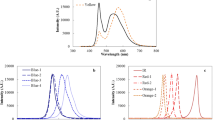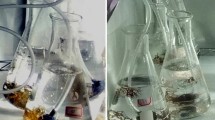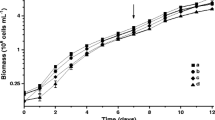Abstract
A study was conducted to investigate the effect of light intensity (21, 42, and 63 μmol photons m−2 s−1) and photoperiod (8:16, 12:12, and 16:8 h light/dark) on the biomass production and its biochemical composition (total carotenoids, chlorophyll a, phycoerythrin (PE), phycocyanin (PC) and allophycocyanin (APC), total protein, and carbohydrates) of a local isolate of Nostoc calcicola. The results revealed that N. calcicola prefers dim light; however, the most of the levels of light intensity and photoperiod investigated did not have a significant impact on biomass production. Increasing light intensity biomass content of chlorophyll a, PE, PC, APC, and total protein decreased, while total carotenoids and carbohydrate increased. The same behavior was observed also when light duration (photoperiod) increased. The interaction effect of increasing light intensity and photoperiod resulted in an increase of carbohydrate and total carotenoids, and to the decrease of chlorophyll a, PE, PC, APC, and total protein content. The results indicate that varying the light regime, it is capable to manipulate the biochemical composition of the local isolate of N. calcicola, producing either valuable phycobiliproteins or proteins under low light intensity and shorter photoperiods, or producing carbohydrates and carotenoids under higher light intensities and longer photoperiods.




Similar content being viewed by others
References
Knoll, A. H. (2008). Cyanobacteria and earth history. The Cyanobacteria: Molecular Biology, Genomics, and Evolution, 484
Rastogi, R. P., & Sinha, R. P. (2009). Biotechnological and industrial significance of cyanobacterial secondary metabolites. Biotechnology Advances, 27, 521–539.
Singh, R. K., Tiwari, S. P., Rai, A. K., & Mohapatra, T. M. (2011). Cyanobacteria: an emerging source for drug discovery. The Journal of Antibiotics, 64, 401–412.
Balat, H. (2010). Prospects of biofuels for a sustainable energy future: a critical assessment. Energy Education Science and Technology Part a-Energy Science and Research, 24, 85–111.
Groom, M. J., Gray, E. M., & Townsend, P. A. (2008). Biofuels and biodiversity: principles for creating better policies for biofuel production. Conservation Biology, 22, 602–609.
Renaud, S., Parry, D., Thinh, L.-V., Kuo, C., Padovan, A., & Sammy, N. (1991). Effect of light intensity on the proximate biochemical and fatty acid composition of Isochrysis sp. and Nannochloropsis oculata for use in tropical aquaculture. Journal of Applied Phycology, 3, 43–53.
Meseck, S. L., Alix, J. H., & Wikfors, G. H. (2005). Photoperiod and light intensity effects on growth and utilization of nutrients by the aquaculture feed microalga, Tetraselmis chui (PLY429). Aquaculture, 246, 393–404.
Danesi, E. D. G., Rangel-Yagui, C. O., Carvalho, J. C. M., & Sato, S. (2004). Effect of reducing the light intensity on the growth and production of chlorophyll by Spirulina platensis. Biomass and Bioenergy, 26, 329–335.
Khotimchenko, S. V., & Yakovleva, I. M. (2005). Lipid composition of the red alga Tichocarpus crinitus exposed to different levels of photon irradiance. Phytochemistry, 66, 73–79.
Jeon, Y.-C., Cho, C.-W., & Yun, Y.-S. (2006). Combined effects of light intensity and acetate concentration on the growth of unicellular microalga Haematococcus pluvialis. Enzyme and Microbial Technology, 39, 490–495.
Brown, M. R., & Hohmann, S. (2002). Effects of irradiance and growth phase on the ascorbic acid content of Isochrysis sp. T. ISO (Prymnesiophyta). Journal of Applied Phycology, 14, 211–214.
Bouterfas, R., Belkoura, M., & Dauta, A. (2006). The effects of irradiance and photoperiod on the growth rate of three freshwater green algae isolated from a eutrophic lake. Limnetica, 25, 647–656.
Hashtroudi, M. S., Shariatmadari, Z., Riahi, H., & Ghassempour, A. (2013). Analysis of Anabaena vaginicola and Nostoc calcicola from Northern Iran, as rich sources of major carotenoids. Food Chemistry, 136, 1148–1153.
Komárek, J. (2010). Modern taxonomic revision of planktic nostocacean cyanobacteria: a short review of genera. Hydrobiologia, 639, 231–243.
Zehnder, A., & Gorham, P. R. (1960). Factors influencing the growth of Microcystis aeruginosa Kütz Emend. Elenkin. Canadian Journal of Microbiol, 6, 645–660.
Premila, V., & Umamaheswara Rao, M. (1997). Effect of crude oil on the growth and reproduction of some benthic marine algae of Visakhapatnam coastline. Indian Journal of Marine Science, 26, 195–200.
Aminot, A. and Rey, F. (2000). Standard procedure for the determination of chlorophyll a by spectroscopic methods. International Council for the Exploration of the Sea, 1–12.
Wyman, M., & Fay, P. (1986). Underwater light climate and the growth and pigmentation of planktonic blue-green algae (Cyanobacteria) I. The influence of light quantity. Proceedings of the Royal Society of London B. Biological Sciences, 227, 367–380.
Bogorad, L. (1975). Phycobiliproteins and complementary chromatic adaptation. Annual Review of Plant Physiology, 26, 369–401.
Gerhardt, P., Wood, W. A. and Krieg, N. R. (1994). Methods for general and molecular bacteriology.ed. American Society for Microbiology Washington, DC.
Schneegurt, M. A., Sherman, D. M., Nayar, S., & Sherman, L. A. (1994). Oscillating behavior of carbohydrate granule formation and dinitrogen fixation in the cyanobacterium Cyanothece sp. strain ATCC 51142. Journal of Bacteriology, 176, 1586–1597.
Meijer, E., & Wijffels, R. (1998). Development of a fast, reproducible and effective method for the extraction and quantification of proteins of micro-algae. Biotechnology Techniques, 12, 353–358.
Bradford, M. M. (1976). A rapid and sensitive method for the quantitation of microgram quantities of protein utilizing the principle of protein-dye binding. Analytical Biochemistry, 72, 248–254.
Hu, Q. (2004). in Handbook of microalgal culture: biotechnology and applied phycology, (Richmond, A., ed.), Blackwell Publishing Ltd, Oxford.
De Nobel, W. P., Matthijs, H. C., Von Elert, E., & Mur, L. R. (1998). Comparison of the light‐limited growth of the nitrogen‐fixing cyanobacteria Anabaena and Aphanizomenon. New Phytologist, 138, 579–587.
Grobbelaar, J. U. (2004). in Handbook of microalgal culture: Biotechnology and applied phycology, (Richmond, A., ed.), Blackwell Publishing Ltd., Oxford, pp. 97–115.
Sánchez-Saavedra, M. (2002). Effect of photon fluence rates of white and blue-green light on growth efficiency and pigment content of three diatom species in batch cultures Efecto de las tasas de flujo de fotones de luz blanca y azul-verde cn la eficiencia del crecimiento y contenido de pigmentos de tres especies de diatomcas en cultivos temrinales. Ciencias do Mar, 28, 273–279.
Richmond, A. (2004). Biological principles of mass cultivation. Handbook of microalgal culture: Biotechnology and applied phycology, 125–177
Ak, I., Cirik, S. and Göksan, T. (2008). Effects of Light Intensity, Salinity and Temperature on Growth in Çamaltı Strain of Dunaliella viridis Teodoresco from Turkey. Journal of Biological Sciences, 8
Poza-Carrión, C., Fernández-Valiente, E., Piñas, F. F., & Leganés, F. (2001). Acclimation of photosynthetic pigments and photosynthesis of the cyanobacterium Nostoc sp. strain UAM206 to combined fluctuations of irradiance, pH, and inorganic carbon availability. Journal of Plant Physiology, 158, 1455–1461.
Post, A. F., de Wit, R., & Mur, L. R. (1985). Interactions between temperature and light intensity on growth and photosynthesis of the cyanobacterium Oscillatoria agardhii. Journal of Plankton Research, 7, 487–495.
Vernotte, C., Astier, C., & Olive, J. (1990). State 1-state 2 adaptation in the cyanobacteria Synechocystis PCC 6714 wild type and Synechocystis PCC 6803 wild type and phycocyanin-less mutant. Photosynthesis Research, 26, 203–212.
Kim, J. H., Nemson, J. A., & Melis, A. (1993). Photosystem II reaction center damage and repair in Dunaliella salina (green alga) (analysis under physiological and irradiance-stress conditions). Plant Physiology, 103, 181–189.
Sforza, E., Simionato, D., Giacometti, G. M., Bertucco, A., & Morosinotto, T. (2012). Adjusted light and dark cycles can optimize photosynthetic efficiency in algae growing in photobioreactors. PLoS ONE, 7, e38975.
Zhu, C., Lee, Y., Chao, T., & Lim, S. (1997). Diurnal changes in gross chemical composition and fatty acid profiles of Isochrysis galbana TK1 in outdoor closed tubular photobioreactors. Journal of Marine Biotechnology, 5, 153–157.
Valenzuela-Espinoza, E., Millán-Núñez, R., & Núñez-Cebrero, F. (2002). Protein, carbohydrate, lipid and chlorophyll a content in Isochrysis aff. galbana (clone T-Iso) cultured with a low cost alternative to the f/2 medium. Aquacultural Engineering, 25, 207–216.
Markou, G., Angelidaki, I., & Georgakakis, D. (2013). Bioethanol production by carbohydrate-enriched Arthrospira (Spirulina) platensis. Energies, 6, 3937–3950.
Latasa, M. (1995). Pigment composition of Heterocapsa sp. and Thalassiosira weissflogii growing in batch cultures under different irradiances. Scientia Marina, 59, 25–37.
Sandnes, J., Källqvist, T., Wenner, D., & Gislerød, H. R. (2005). Combined influence of light and temperature on growth rates of Nannochloropsis oceanica: linking cellular responses to large-scale biomass production. Journal of Applied Phycology, 17, 515–525.
Ogbonda, K. H., Aminigo, R. E. and Abu, G. O. (2007). Influence of aeration and lighting on biomass production and protein biosynthesis in a Spirulina sp. isolated from an oil-polluted brackish water marsh in the Niger Delta, Nigeria. Afr. J. Biotechnol., 6
Peña, M. R., & Villegas, C. T. (2005). Cell growth, effect of filtrate and nutritive value of the tropical Prasinophyte Tetraselmis tetrathele (Butcher) at different phases of culture. Aquaculture Research, 36, 1500–1508.
Foy, R., & Gibson, C. (1982). Photosynthetic characteristics of planktonic blue-green algae: changes in photosynthetic capacity and pigmentation of Oscillatoria redekei Van Goor under high and low light. British Phycological Journal, 17, 183–193.
Falkowski, P. G., & Owens, T. G. (1980). Light—shade adaptation: two strategies in marine phytoplankton. Plant Physiology, 66, 592–595.
Author information
Authors and Affiliations
Corresponding author
Rights and permissions
About this article
Cite this article
Khajepour, F., Hosseini, S.A., Ghorbani Nasrabadi, R. et al. Effect of Light Intensity and Photoperiod on Growth and Biochemical Composition of a Local Isolate of Nostoc calcicola . Appl Biochem Biotechnol 176, 2279–2289 (2015). https://doi.org/10.1007/s12010-015-1717-9
Received:
Accepted:
Published:
Issue Date:
DOI: https://doi.org/10.1007/s12010-015-1717-9




